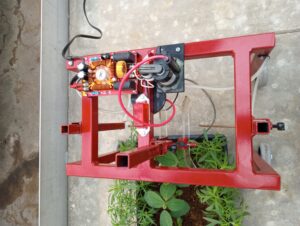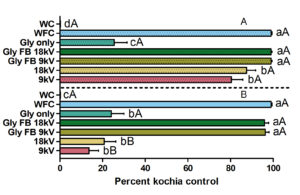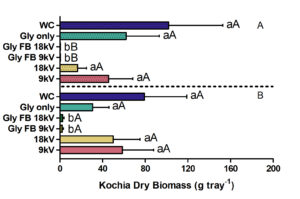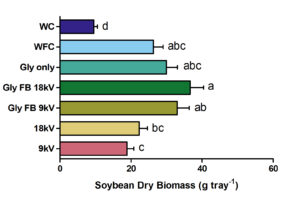Final report for GNC23-363
Project Information
The proposed project, entitled ‘Integrated weed management of herbicide resistant kochia in North Dakota’ developed and evaluated efficacy of a novel electrocution system in conjunction with single glyphosate application to control glyphosate-resistant kochia in North Dakota. Glyphosate-resistant kochia (Bassia scoparia (L.) A. J. Scott.) proliferation in North Dakota agricultural systems has raised concerns about potential crop yield losses and continued efficacy of chemical weed control. Addressing this issue requires the implementation of integrated weed management strategies for the control of kochia in soybean (Glycine max L.), a crop for which kochia control options are quickly dwindling. A greenhouse study was conducted to evaluate a small-scale electrocution device, used alone and in combination with glyphosate, to control inter-row glyphosate-resistant kochia in soybean. The electrocution device consisted of a mobile platform mounted with a negative terminal to ground electrical current into the soil, a positive terminal to pass current into weed plants via contact, and a glass cover to protect crop plants. An initial experiment evaluated two voltages (9kV or 18kV), travel speeds (20 or 40-seconds tray-1), and kochia biotypes (resistant vs. susceptible). A second experiment evaluated seven treatments: 9kV, 18kV, glyphosate followed by 9kV, glyphosate followed by 18kV, glyphosate only, weedy check, and weed-free check. The travel speed was 40-seconds tray-1. Glyphosate was applied at 1680 g ae ha-1 with AMS at 2.5% v/v. Glyphosate-tolerant soybeans (AG009X8) were planted in the center of the tray. In the initial experiment, kochia control at travel speed of 40-second tray-1 (84%) was greater compared to 20-second tray-1 (70%). In the second experiment, glyphosate followed by 9kV and glyphosate followed by 18kV treatments provided greater kochia control (99%) compared to 18kV, 9kV and glyphosate only (88%, 80% and 25%, respectively) in the first run, with similar pattern in the second run. No soybean injury occurred and glyphosate followed by 18kV produced greater soybean biomass compared to weedy check. Overall, electrocution combined with glyphosate maximized control of inter-row glyphosate-resistant kochia and soybean biomass. The combination of electrocution and glyphosate offered a highly effective weed management strategy, enhancing the overall weed control efficacy in soybean systems.
The objective of these experiments was to develop and test a novel electrical weeder (a prototype) capable of targeting inter-row kochia in soybean within greenhouse trays. Electrical weeding alone or in combination with a single glyphosate application was evaluated to control inter-row glyphosate-resistant kochia. The results of this study will benefit both organic and conventional farmers who are interested in reducing herbicide applications to control kochia and other weeds by using proposed integrated weed management strategy. Although we evaluated electrical weeding and glyphosate combination on herbicide resistant kochia in greenhouse trays, we plan to use the results as preliminary data to apply for a larger grant to extend the results to many other crop species at field scale. The proposed project resulted in scientists/researchers and students learning about integration of electrocution and glyphosate to control kochia in soybean production systems at two conferences (North Central Weed Science Society Annual Meeting and Western Society of Weed Science Annual Meeting). These studies also provided a PhD student with training in developing a research proposal, designing and conducting weed science experiments, managing a research grant, writing reports, and presenting findings at two professional conferences that contributed substantially to his doctoral training.
Cooperators
Research
Two separate experiments were conducted in a greenhouse at North Dakota State University (NDSU), Fargo, ND. Glyphosate-susceptible kochia seeds were collected from Moorhead, MN. Glyphosate-resistant (GR) kochia biotype was sampled from Prosper, ND and seeds for glyphosate-tolerant soybean cultivar were donated by NDSU soybean breeding program for these experiments. The electrical weeder used in this study was designed to operate on an experimental unit of a 0.25 × 0.51 m planting tray (Figure 1). This prototype targeted kochia plants surrounding a single row of soybean seedlings, with electrodes directly contacting the kochia while the soybean row remained shielded from direct electrode contact. The circuit was completed by inserting the negative terminal into the soil and bringing the positive terminal into contact with the plants. This mechanism subjected the plants to an electrical shock, disrupting their cellular structure. The high voltage caused cell damage due to heat, leading to partial or full plant mortality.
An initial experiment was conducted to quantify effective travel speed for the electrical weeder aimed at improving GR kochia control. A randomized complete block design (RCBD) with factorial arrangement was used with three replications. The treatment factors included two kochia biotypes (glyphosate-susceptible and GR), two voltage levels (9kV and 18kV), and two travel speeds of the electrical weeder (20- and 40-seconds tray-1). The kochia plants were electrocuted when they reached a height of 0.05-0.08 m. The second experiment was conducted in two experimental runs, using a randomized complete block design (RCBD) with four replications. These experiments were focused on evaluating the efficacy of weed electrocution alone and glyphosate followed by weed electrocution for GR kochia control and soybean injury. The treatments evaluated in these experiments included: 9kV, 18kV, glyphosate followed by 9kV, glyphosate followed by 18kV, glyphosate only, a weedy check, and a weed-free check. Glyphosate was applied at a rate of 1680 g ae ha-1, with ammonium sulfate (AMS) at 2.5% v/v. The travel speed of the electrical weeder was kept at 40 seconds tray-1. For treatments which involved glyphosate followed by electrocution, the weed electrocution was applied 7 days after the glyphosate. For the first experimental run, kochia plants were electrocuted at 0.05-0.10 m tall. However, kochia plants were 0.13-0.15 m tall for the second experimental run at the time of electrocution. Electrical weeding was performed at V1-V2 soybean growth stage at both experimental runs.
For both experiments, data collection began 7 days after the electrocution treatment application (DAT). Percent kochia control was evaluated on 7, 14, and 21 DAT. Kochia plant shoots were harvested on 21 DAT and dried at 60°C to quantify above-ground dry biomass. Additionally, percent soybean injury relative to the weed-free treatment was visually estimated on 7, 14, and 21 DAT. Soybean plants were then harvested at 21 DAT and dried at 60°C to quantify above-ground soybean dry biomass.

Initial experiment
For the initial experiment, voltage rates did not affect kochia control for all sampling periods. At 7 DAT, 30% and 32% kochia control was achieved with the travel speed of 20 and 40 seconds tray-1, respectively. At 14 DAT, 70% kochia control was observed at travel speed of 20 seconds tray-1 compared to 84% kochia control at 40 seconds tray-1. Kochia control remained consistent at 21 DAT between the travel speeds. This indicated that the electrical energy provided to the kochia plants caused slow necrosis and cell death, requiring 7-14 days after weed electrocution for complete plant death. These outcomes align with a field study using commercial electrical weeder, wherein kochia control increased from 44% to 76% within 7-14 days. A similar pattern was noticed for waterhemp [Amaranthus tuberculatus (Moq.) J. D. Sauer] control over the same period (Peters et al. 2020). For the initial experiment, kochia control was greater at a travel speed of 40 seconds tray-1 compared to 20 seconds at both 14 and 21 DAT. Yellow nutsedge shoot growth was 45% higher when plants were treated with electrical weeder at a speed of 2.2 or 3.0 km h-1 compared to 1.1 km h-1 (Feys et al. 2023).
Second experiment
For the second experiment, glyphosate followed by weed electrocution resulted in greater kochia control for all sampling periods in both experimental runs. For the current experiment, glyphosate application thinned kochia density and provided a synergistic effect in combination with electrocution whereby glyphosate-stressed kochia plants were easily killed by a small amount of electrical energy. Brown et al. (2019) found that electrocution of herbicide-resistant horseweed (Erigeron canadensis L.) that survived initial herbicide application provided greater control compared to herbicide alone. However, the impact of weed electrocution alone on herbicide-resistant horseweed was not considered. Similarly, pre-emergence glyphosate combined with electrical weeding resulted in greater weed suppression compared to electrical weeding without pre-emergence herbicide (Koch et al. 2020). Thus, integrating inter-row electrical weeding in conventional soybean production systems along with herbicides will improve the efficacy of herbicide-resistant weed suppression. However, greater electrical energy was required to suppress larger sized weeds (Lati et al 2021). Consequently, using electrical weeding alone will require a greater amount of electrical energy to optimize weed control.
At 14 DAT (Figure 2), kochia control from electrical weeding was greater during the first experimental run (80 to 88% tray-1) compared to the second (14 to 21% tray-1). Kochia grew more slowly in the first experimental run and plants were 0.05-0.10 m tall when electrocuted. For the second run, kochia had reached 0.13-0.15 m tall when electrocution was performed. Moore et al. (2023) stated that electrical weeding was less effective on large amounts of weed biomass. Electrical weeding applied at early growth stages improved weed control efficacy and more electrical energy was required to control taller weeds (Rasmusson et al. 1980; lati et al. 2021). Electrical weeding is most effective when each individual weed plant receives sufficient electrical energy to trigger cell and tissue necrosis leading to plant death. Thus, electrode contact with each individual weed plant is essential to optimize control (Schreier et al. 2022). For the current study, the observed decline in electrical weeding efficacy in the second experimental run could be attributed to the greater biomass of kochia plants which may resulted in some plants shielding other neighboring plants as the electrode moved along the planting tray. Similarly, a lightening weeder modified to target inter-row weeds failed due to very high weed densities in the field (Slaven et al. 2023). For the best effects, it is important to target the inter-row weeds at early growth stages (i.e., 0.05-0.10 m tall).
Kochia biomass was suppressed only in glyphosate followed by electrocution compared to weedy check (Figure 3). Rowland et al. (2023) indicated that weed electrocution alone did not reduce weed biomass compared to non-treated control. Similarly, results from the current study indicated that weed electrocution alone was not effective at suppressing weed biomass. However, integrating electrical weeding with post-emergence herbicide improved herbicide-resistant weed suppression.
Soybean plants were successfully shielded from direct electrode contact and exhibited no electrical injury (data not presented). For the current study, soybean plant biomass was improved in all treatments compared to the weedy check (Figure 4). Rowland et al. (2023) indicated that weed electrocution treatment targeting weeds taller than crop canopy did not improve soybean yield compared to non-treated control. In contrast, the current study targeted inter-row weeds at an early soybean growth stage. Soybean biomass was greater for glyphosate followed by 18kV compared to the weedy check and electrocution only treatments.



Educational & Outreach Activities
Participation Summary:
Conference Proceedings, Abstracts:
Ahmad W, Gramig G. 2025. Inter-row electrocution improves glyphosate-resistant kochia (Bassia scoparia) control. Western Society of Weed Science Annual Meeting. March 10-13. Seattle, WA.
Ahmad W, Gramig G. 2024. Integrating inter-row electrocution and glyphosate manages glyphosate-resistant kochia (Bassia scoparia). 79th Annual Meeting, North Central Weed Science Society. December 9-12. Kansas City, MO.
Peer Reviewed Articles:
These results will be submitted for publication in a peer-reviewed journal either Weed Technology or Weed Research journal.
Project Outcomes
This research demonstrated that integrating inter-row electrical weeding with single glyphosate application improved control of glyphosate-resistant kochia in soybean systems, particularly when kochia was treated at early growth stages. The study found that electrical weeding alone was less effective in reducing weed biomass, especially with taller kochia plants, while combining it with glyphosate enhanced weed suppression and protected soybean biomass. The experimental results support the potential of inter-row electrical weeding as a viable tool in integrated weed management to reduce reliance on repeated glyphosate applications. This greenhouse-based study lays the foundation for future field-scale trials and technology refinement for more sustainable weed control practices.
Throughout this project, both my advisor and I deepened our knowledge, skills, and awareness of sustainable agriculture practices, particularly in integrated weed management. At the start of this study, we knew that glyphosate-resistant kochia would survive single glyphosate application alone, and controlling it typically required mixing herbicides with different modes of action or multiple herbicide applications, raising environmental concerns due to multiple herbicide applications. While we were aware that electrocution with very high electrical energy could control taller weeds above the crop canopy, we lacked understanding of how inter-row electrical weeding using lower energy, alone or combined with glyphosate, would perform. Through this research, our knowledge and awareness of sustainable weed management substantially improved. We learned that integrating inter-row electrocution with a single glyphosate application can effectively control glyphosate-resistant kochia, especially when treated early. Electrocution alone also showed potential when weeds were small, although higher energy would be needed for taller weeds. This approach enhances the sustainability of soybean production by reducing dependence on repeated herbicide use and offering an alternative tool for integrated weed management.